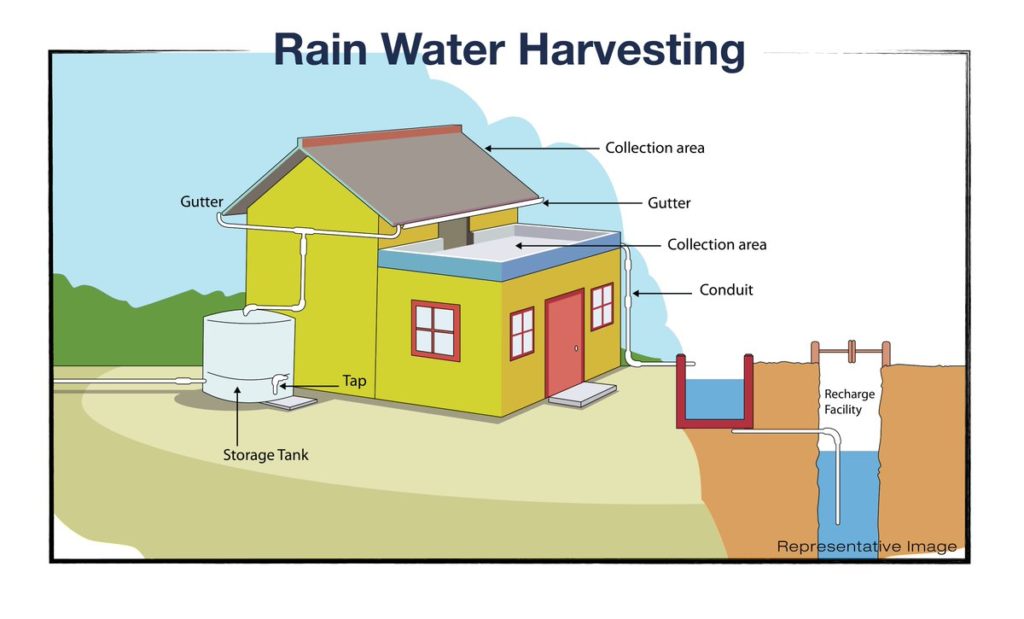Rainwater Harvesting System its component and Factor affecting it.
We know that all living things like animals, humans, and plants needing water to live and carried out the different types of cellular activities.

So we can’t imagine a day without water. It’s very hard to imagine because we all use water for different kinds of daily activities, like cooking, cleaning, washing, drinking, and other more industrial and domestic uses.
Today we all are heading towards the scarcity of water, and it’s mainly because of the lack of water conservation and also the pollution of water bodies.
So let and don’t waste any drop of water and start the conversing water for other uses.
“Rainwater harvesting is the simple process or technology used to convert rainwater by storing, collecting, purifying, and conveying rainwater that runoff from roads, parks, rooftops, etc. For later use.”
It’s a process of storage and accumulation of rainwater for reuse rather than allowing it to runoff.
Components of Rainwater Harvesting System.
- The catchment use to collect capture and store the rainwater
- The system of conveying used to transport the harvested water from the catchment to the recharge zone
- The flush system was used for flushing out the started spell of rain.
- A filter system was used to filter the collected rainwater and removed the pollutant.
- Recharge structure and tanks used to store filtered rainwater.

The procedure of rainwater harvesting system includes the storage and collection of rainwater with the help of an artificially designed system that Ruoff man-made or naturally catchment areas such as rocks surface, hill slopes, rooftops, and artificially repairs the semi-previous land surface and impervious land surface.
Several factors can play the main role in the amount of water harvested system
Some of these factors following as:
- Feature of the catchment of the water.
- Impact on the environment as well.
- Storage tanks capacity.
- Technology availability.
- Runoff quantum.
Why do we harvest rainwater?
The rainwater harvest system is one of the greatest methods practiced and followed to support the conservation of water.
Now, scarcity of the best quality water has become a significant issue of concern.
However, the rainwater, which is naturally pure and of the best quality, can be used for irrigation, cooking, washing, cleaning, batching, and also for other more livestock equipment.
Different methods of rainwater harvesting system
It includes rooftop rainwater.
- Transportation.
- Filter.
- Flush, first.
- Catchment.
- Surface runoff harvesting.
Advantages of rainwater harvesting system
- Reduce cost.
- Reduce the diameter of water.
- No need for a filtration system for landscape irrigation.
- Rainwater harvesting is a simple method and easy to practice.
- It improves the quantity and quality of groundwater.
- This technology is simple, easy to operate and install.
- It reduces soil erosion, flooding, runoff, stormwater, and pollution of surface water with pesticides, fertilizers, metals, and other sediments.
- It is a great source of water for landscape irrigation with no dissolved salts, chemicals and also free from all minerals.
Disadvantages of rainwater harvesting system
- It required regular maintenance.
- It required the best technical skill for installation.
- If we don’t install it correctly, it may attract the mosquito and more other born water diseases.
- Storage of rainwater harvesting systems is limited.
- It can limit the supply of rainwater.
What is the importance of the rainwater harvesting system?
It’s a sustainable process and helps in preserving the water for future requirements.
The scarcity of water is the main concern in today’s scenario.
The procedure of rainwater harvesting is the best way to conserve water.
Factors affecting the amount of rain water harvested
Environment factors:
- Rainfall distribution,
- The Intensity and dry period
- Quality of rainwater and the availability of other more resources of water and impact on the environment.
Technical factors:
- Demand for water,
- Different type of system,
- Different uses of the system,
- Technology availability for catchment areas,
- Runoff coefficient material,
- Slop and types of roofs,
- The capacity of storage tanks,
- Delivery system, location of the cistern,
- Geology of cistern site and
- Different methods of water treatment.
Economic factors:
- Budget’s availability,
- Construction’s cost,
- Maintenance reduction in utility bills.
Operational factors:
- Organization policies,
- Regulations of the government,
- Safety of the system and
- Response of workers.
